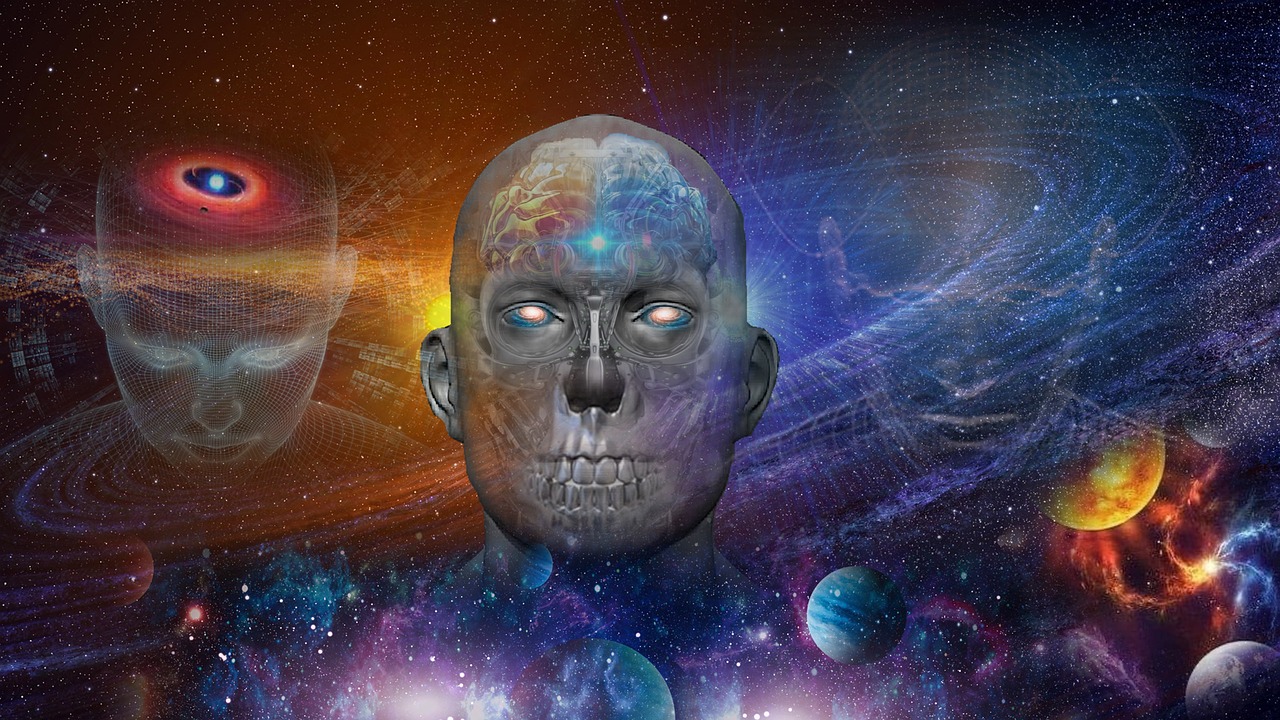Metaphysics - Theoretical Approach to the Unobserved
Metaphysics, often seen as the foundation of philosophy, invites us to embark on a journey into the depths of reality itself. It's like peering behind the curtain of existence, where the tangible world gives way to the unobservable aspects that shape our understanding of life, the universe, and everything in between. But what exactly is metaphysics? At its core, it seeks to answer profound questions about being, existence, and the very fabric of the universe. Imagine standing at the edge of a vast ocean, where the waves of thought crash against the shores of our perception. Each question we ask is like a ripple in that water, expanding outward into the unknown.
Throughout history, metaphysics has evolved, adapting to new ideas and challenges. It's a field that doesn't shy away from the abstract and complex; rather, it embraces them. Think of it as a grand tapestry woven from the threads of human thought, where each philosopher adds their unique color and texture. From the ancient musings of Aristotle to the revolutionary ideas of Kant, metaphysics has continually pushed the boundaries of what we consider real.
In this exploration, we will delve into the key principles of metaphysics, examining its historical significance and the influential thinkers who have shaped its discourse. We'll uncover the mysteries of existence and the nature of reality, engaging with the very questions that have puzzled humanity for centuries. Are we mere observers in a vast universe, or do we play an active role in shaping our reality? The answers may not be straightforward, but that's part of the beauty of metaphysics—it encourages us to question, to ponder, and to explore the unobservable realms of existence.
As we navigate through this article, you’ll find that metaphysics is not just an abstract concept, but a living, breathing field of inquiry that resonates with our everyday experiences. Whether it's the nature of time, the existence of unobservable entities, or the essence of being, metaphysics invites us to think deeply and critically about the world we inhabit. So, let's dive in and explore the rich landscape of metaphysical thought, where every question leads to new discoveries and every answer opens the door to more mysteries.
- What is metaphysics? Metaphysics is a branch of philosophy that studies the fundamental nature of reality, including concepts such as being, existence, and the universe.
- Who are the key philosophers in metaphysics? Influential figures include Aristotle, Kant, and Heidegger, each contributing unique perspectives to metaphysical discussions.
- What are some central questions in metaphysics? Questions often revolve around the nature of existence, the reality of unobservable entities, and the essence of time.
- How does metaphysics relate to other branches of philosophy? Metaphysics intersects with epistemology, ethics, and logic, influencing and being influenced by these fields.

Understanding Metaphysics
Metaphysics is not just a dry, academic subject; it’s an exhilarating journey into the very fabric of reality. Imagine standing at the edge of a vast ocean, peering into the depths where the known meets the unknown. This branch of philosophy dives deep into the fundamental nature of reality, exploring profound questions about being, existence, and the universe itself. At its core, metaphysics seeks to answer the big questions that often leave us scratching our heads: What is real? What does it mean to exist? And how do the unobservable aspects of the universe play into our understanding of life?
Historically, metaphysics has been a cornerstone of philosophical inquiry, dating back to the ancient Greeks. Think of it as the philosophical equivalent of a detective story, where each philosopher adds their own twist to the narrative. The term "metaphysics" itself was coined by Aristotle, who used it to describe the study of what lies beyond the physical world. This discipline encompasses a variety of concepts, including ontology (the study of being), cosmology (the study of the universe), and epistemology (the study of knowledge). Each of these branches contributes to our understanding of the metaphysical landscape.
One of the most fascinating aspects of metaphysics is its ability to challenge our perceptions of reality. For instance, consider the age-old debate over whether objects exist independently of our perception. This question leads us into the realms of realism and anti-realism, two opposing views that shape contemporary metaphysical discussions. Realists argue that unobservable entities, like electrons or black holes, exist regardless of our awareness of them. In contrast, anti-realists contend that these entities only exist as concepts within our minds. This tug-of-war between perspectives illustrates just how intricate and layered metaphysical inquiry can be.
Moreover, metaphysics is not just a relic of the past; it is a living, breathing field of study that continues to evolve. Today, philosophers grapple with questions surrounding the nature of time, causality, and the very essence of reality itself. For example, debates about whether time is linear or cyclical can feel like an intellectual rollercoaster, inviting us to reconsider how we perceive our own lives. Are we merely passengers on a train of time, or do we have the agency to shape our journey?
In summary, metaphysics invites us to explore the uncharted territories of existence, challenging our assumptions and expanding our understanding of reality. It’s a realm where philosophy meets science, and where the questions we ask can lead to profound insights about ourselves and the universe we inhabit. So, the next time you find yourself pondering the nature of reality, remember that you’re not alone; countless thinkers have embarked on this quest, each contributing to the rich tapestry of metaphysical thought.
- What is metaphysics? Metaphysics is a branch of philosophy that explores the fundamental nature of reality, including concepts like existence, being, and the universe.
- Who are some key philosophers in metaphysics? Influential figures include Aristotle, Immanuel Kant, and Martin Heidegger, each contributing unique perspectives to metaphysical thought.
- What are the main topics in metaphysics? Key topics include ontology, cosmology, the nature of time, and the debate between realism and anti-realism.
- Why is metaphysics important? Metaphysics helps us understand the fundamental principles that govern reality, shaping our views on existence and knowledge.

Key Philosophers in Metaphysics
Throughout history, metaphysics has been shaped and defined by the profound thoughts of various philosophers. These thinkers have not only explored the nature of reality but have also challenged existing beliefs and introduced revolutionary ideas that continue to resonate today. When we mention metaphysics, names like Aristotle, Kant, and Heidegger often come to mind. Each of these philosophers has contributed uniquely to the field, offering perspectives that range from the essence of being to the complexities of human perception.
Aristotle, often regarded as the father of metaphysics, laid down the foundational concepts that would influence countless generations. His exploration of substance and essence invites us to ponder what it means to exist. In contrast, Immanuel Kant turned the tables on traditional metaphysical thought. He argued that our understanding of reality is not merely a reflection of the world but is shaped by our own perceptions and cognitive frameworks. This idea was revolutionary and sparked debates that echo in contemporary philosophy.
Then we have Martin Heidegger, a philosopher who took a different approach by focusing on existence itself. He questioned the very nature of being and how it relates to time and space. His existential inquiry opened up new avenues in metaphysical discussions, emphasizing the importance of human experience and the subjective nature of reality.
To better understand the contributions of these key philosophers, let's summarize their main ideas:
| Philosopher | Main Contribution | Key Concepts |
|---|---|---|
| Aristotle | Foundation of Metaphysics | Substance, Essence, Potentiality, Actuality |
| Kant | Critique of Pure Reason | Phenomena, Noumena, Human Perception |
| Heidegger | Existential Metaphysics | Being, Time, Dasein |
As we delve deeper into the thoughts of these philosophers, we uncover a rich tapestry of ideas that challenge our understanding of reality. Each philosopher's unique lens offers us a way to question not just what exists, but how we come to understand existence itself. Their contributions are not just historical footnotes; they are living ideas that continue to inspire debates and discussions in philosophical circles today.
In conclusion, the legacy of these key philosophers serves as a reminder of the complexity and depth of metaphysical inquiry. As we explore their ideas, we are not merely studying the past; we are engaging with the very questions that define our existence. What does it mean to be? How do we know what we know? These questions remain as relevant now as they were centuries ago, urging us to explore the unobserved aspects of the universe.
- What is metaphysics? Metaphysics is a branch of philosophy that studies the fundamental nature of reality, including concepts such as being, existence, and the universe.
- Who are the key philosophers in metaphysics? Key philosophers include Aristotle, Kant, and Heidegger, each contributing unique perspectives on metaphysical questions.
- Why is metaphysics important? Metaphysics is crucial because it addresses the foundational questions of existence and reality, influencing various fields such as science, religion, and ethics.
- How does Kant's philosophy differ from Aristotle's? Kant emphasized the role of human perception in understanding reality, while Aristotle focused on the intrinsic nature of substances and their properties.

Aristotle's Contribution
When we talk about metaphysics, we can't overlook the profound influence of Aristotle, a philosopher whose thoughts laid the groundwork for much of Western philosophy. His contributions are akin to the bedrock of a grand structure, providing stability and support for the intricate ideas that followed. Aristotle's exploration of substance and causality not only shaped metaphysical inquiry but also framed the way we perceive reality itself. Imagine trying to build a house without a solid foundation; that's what metaphysics would be without Aristotle's insights.
One of Aristotle's key ideas is the distinction between substance and essence. For him, substance refers to what something is—its tangible existence—while essence pertains to the qualities that make it what it is. This distinction is crucial because it invites us to ponder questions like, "What defines the identity of an object?" and "Is there more to reality than what we can observe?" Aristotle suggests that to truly understand the nature of reality, we must dive deep into these concepts, much like a diver exploring the depths of the ocean to uncover hidden treasures.
Furthermore, Aristotle introduced the concepts of potentiality and actuality. These ideas illustrate the dynamic nature of existence, where entities are not static but are in a constant state of becoming. Potentiality refers to the inherent capacity of something to develop into a specific state, while actuality is the realization of that potential. Think of a seed: it has the potential to become a towering oak tree, but it only becomes actualized when it receives the right conditions—soil, water, and sunlight. This analogy perfectly encapsulates Aristotle's view of reality as a vibrant tapestry, woven together by the threads of potential and actual existence.
In summary, Aristotle's contributions to metaphysics are not just historical footnotes; they are vital components of our philosophical toolkit. His ideas challenge us to question our understanding of existence and reality, urging us to look beyond the surface. By distinguishing between substance and essence, and by exploring the interplay of potentiality and actuality, Aristotle invites us into a deeper conversation about the very nature of being. His work serves as a reminder that philosophy is not merely an academic pursuit but a journey into the heart of existence itself.
- What is metaphysics? Metaphysics is a branch of philosophy that examines the fundamental nature of reality, including concepts such as being, existence, and the universe.
- Who was Aristotle? Aristotle was an ancient Greek philosopher whose work laid the foundation for many areas of philosophy, including metaphysics, ethics, and logic.
- What are substance and essence? Substance refers to what something is in its physical form, while essence pertains to the qualities that define its identity.
- What do potentiality and actuality mean? Potentiality is the capacity for something to develop into a specific state, while actuality is the realization of that potential.

Substance and Essence
When we dive into Aristotle's metaphysical framework, we encounter the profound concepts of substance and essence. These ideas are not just philosophical jargon; they form the very bedrock of understanding what it means to exist. Aristotle posited that everything in the universe is composed of substances, which are the fundamental entities that make up reality. Think of substances as the 'stuff' of the world, the individual things that can exist independently, like a tree, a rock, or even a human being.
But what exactly is the essence of these substances? Aristotle argued that essence refers to the defining characteristics that make a substance what it is. For instance, the essence of a dog is what makes it a dog, distinguishing it from a cat or a tree. This distinction is crucial because, without understanding essence, we would struggle to grasp the true nature of anything. In this way, essence is like the blueprint of a substance, outlining its properties and potentialities.
To illustrate this concept further, consider the following table that highlights the differences between substance and essence:
| Aspect | Substance | Essence |
|---|---|---|
| Definition | The individual entities that exist independently | The defining characteristics that make a substance what it is |
| Example | A specific cat named Whiskers | The qualities that make Whiskers a cat (furry, meows, etc.) |
Understanding the relationship between substance and essence allows us to appreciate the complexity of existence. For Aristotle, recognizing that substances have essences helps us to categorize and comprehend the world around us. It's akin to understanding that while a car is a vehicle (substance), its essence includes being able to transport people, having wheels, and possessing an engine.
Moreover, Aristotle introduced the idea that essence is tied to a substance's function. A substance's essence is not merely a static property; it is dynamic and can evolve over time. For example, a young tree has the essence of a tree, but as it grows, it fulfills its potentiality, becoming more robust and reaching towards the sky. This transition from potentiality to actuality is central to Aristotle's metaphysical thought.
In summary, the exploration of substance and essence is a journey into the core of what it means to exist. By understanding these concepts, we can better navigate the philosophical landscape and appreciate the intricate tapestry of reality that Aristotle laid out so many centuries ago. So, the next time you ponder the nature of existence, remember: substance is what something is, and essence is why it is.
- What is the difference between substance and essence? Substance refers to the individual entities that exist, while essence describes the defining characteristics that make those entities what they are.
- Why are substance and essence important in metaphysics? They help us understand the fundamental nature of reality and categorize different forms of existence.
- How does Aristotle's view of substance and essence differ from modern perspectives? While Aristotle focused on the intrinsic qualities of substances, modern perspectives may emphasize relational and contextual aspects of existence.

Potentiality and Actuality
Aristotle's exploration of potentiality and actuality is like peering into the very fabric of existence itself. Imagine a seed planted in the ground. It holds within it the potential to grow into a towering oak tree, yet until the right conditions are met—sunlight, water, and soil—it remains just a seed. This analogy beautifully illustrates Aristotle's distinction between what something can be (potentiality) and what it is (actuality). Potentiality refers to the inherent capacity of an entity to develop into a specific state or form, while actuality is the realization of that potential. Without this transition from potential to actual, nothing would ever come into being.
In Aristotle's view, every entity in the universe exists in a state of continuous change, oscillating between potentiality and actuality. For instance, consider a sculptor with a block of marble. The marble has the potential to become a magnificent statue, but it only achieves this when the sculptor chisels away at it, bringing forth its actual form. This dynamic interplay is crucial to understanding how reality operates. It suggests that existence is not a static condition but rather a fluid process where potential is constantly being actualized.
To delve deeper, let’s break down these concepts further. Potentiality can be categorized into two types: absolute potentiality and relative potentiality. Absolute potentiality refers to the inherent capabilities of an object, while relative potentiality is contingent upon external factors. For example, a person has the potential to learn a new language (absolute), but their ability to do so may depend on access to resources like classes or tutors (relative). This distinction helps us appreciate the layers of complexity in how potentiality manifests in our lives.
The transition from potentiality to actuality is not merely philosophical; it has practical implications in various fields such as science, art, and personal development. In science, understanding how potential energy transforms into kinetic energy can explain everything from the motion of planets to the functioning of everyday objects. In art, recognizing the potential within a blank canvas drives the creative process. Similarly, in our personal lives, acknowledging our potential can inspire growth and self-improvement.
To summarize, Aristotle's concepts of potentiality and actuality provide a framework for understanding the dynamic nature of reality. They remind us that everything around us is in a constant state of flux, moving from what it could be to what it is. This perspective encourages us to embrace change and recognize the latent possibilities within ourselves and the world. Just as the seed must undergo transformation to become a tree, we too must navigate our potential to realize our fullest selves.
- What is the difference between potentiality and actuality?
Potentiality refers to the inherent capacity of an entity to become something else, while actuality is the realization of that potential. - Can potentiality exist without actuality?
Yes, potentiality can exist in a dormant state, but it requires specific conditions to transition into actuality. - How do these concepts apply to personal growth?
Understanding potentiality and actuality can motivate individuals to recognize their abilities and take action towards self-improvement.

Kant's Metaphysical Revolution
Immanuel Kant was a revolutionary thinker who turned the world of metaphysics on its head. Before Kant, philosophers often took for granted that our understanding of reality was a direct reflection of the world itself. However, Kant introduced a radical idea: our perceptions shape our understanding of reality. This notion was groundbreaking and shifted the focus from the objects of knowledge to the subject doing the knowing. In his seminal work, Critique of Pure Reason, Kant argued that while we can know phenomena (the world as we perceive it), the noumena (the world as it is in itself) remain largely inaccessible to us.
One of Kant's key contributions to metaphysics is the concept of the transcendental idealism. He posited that our experiences are filtered through the lens of our senses and cognitive faculties, which means that we never truly experience things as they are. Instead, we encounter a version of reality that is shaped by our own mental frameworks. This leads to the important conclusion that metaphysics must take into account the limitations of human perception. Kant argued that the structures of our understanding impose certain categories on our experiences, such as space and time, which are not inherent features of the world but rather the conditions under which we can experience it.
Kant's revolutionary ideas also led to the distinction between analytic and synthetic judgments. Analytic judgments are those that are true by definition, such as "all bachelors are unmarried," while synthetic judgments add new information to our understanding of the world, like "the cat is on the mat." Kant emphasized that metaphysical inquiries often rely on synthetic judgments, which can lead to contradictions if not properly grounded in human experience. This brings us to his famous question: What can we know? Through this lens, Kant set the stage for a new approach to metaphysics that respected the limits of human cognition.
Furthermore, Kant's ideas opened the door for future metaphysical debates, particularly concerning the nature of reality and existence. His work inspired subsequent philosophers to grapple with the implications of his theories, leading to a rich discourse on topics such as realism, anti-realism, and the very nature of existence itself. By challenging the assumptions of previous metaphysical thought, Kant encouraged a more critical and reflective approach to understanding reality.
In summary, Kant's metaphysical revolution was not just a shift in perspective; it was a profound transformation in how we engage with the questions of existence and reality. His emphasis on the role of human perception in shaping our understanding has had lasting effects on both philosophy and science. Kant reminds us that while we may strive to uncover the mysteries of the universe, we must also acknowledge the limitations of our own understanding. This duality continues to inspire and challenge philosophers today as they seek to navigate the complex landscape of metaphysical inquiry.
- What is Kant's main contribution to metaphysics? Kant's main contribution is the idea that our understanding of reality is shaped by human perception, leading to the concept of transcendental idealism.
- How did Kant differentiate between analytic and synthetic judgments? Analytic judgments are true by definition, while synthetic judgments add new information about the world.
- What are noumena and phenomena in Kant's philosophy? Noumena refer to things as they are in themselves, while phenomena are the things as we perceive them.

Contemporary Metaphysical Debates
In the ever-evolving landscape of philosophy, are akin to a thrilling chess match, where each move is laden with implications that could reshape our understanding of reality. Today, scholars and thinkers are grappling with profound questions that challenge traditional notions of existence and perception. Two of the most significant debates in modern metaphysics are the tussle between realism and anti-realism, and the intricate nature of time.
The realism vs. anti-realism debate is a fascinating tug-of-war that probes whether entities that we cannot observe—like quarks or dark matter—exist independently of our perceptions. Realists argue that these entities have their own existence, much like a tree falling in a forest, making a sound even if no one is around to hear it. They believe that our scientific theories are reflections of a reality that exists beyond our sensory experiences. In contrast, anti-realists contend that our understanding is inherently tied to human perception, suggesting that without observers, these entities lose their significance. This philosophical standoff raises questions about the nature of truth and existence itself.
To illustrate this debate further, consider the following table that summarizes the core differences between realism and anti-realism:
| Aspect | Realism | Anti-Realism |
|---|---|---|
| Existence of Unobservable Entities | Believes they exist independently | Believes they depend on perception |
| Truth | Objective and independent of observers | Subjective and observer-dependent |
| Scientific Theories | Reflect an external reality | Constructs based on human experience |
Shifting gears, let’s dive into the enigmatic nature of time, which has perplexed philosophers for centuries. Is time a linear progression, or is it more cyclical? This debate is often framed between two prominent theories: presentism and eternalism. Presentism posits that only the present moment is real, while the past and future are mere constructs. This perspective aligns with our everyday experiences, where we feel the immediacy of the now. On the other hand, eternalism suggests that all points in time—past, present, and future—are equally real, much like a vast landscape where every moment exists simultaneously. This view can feel counterintuitive, but it opens up intriguing possibilities about the nature of existence.
As we navigate these contemporary debates, it’s essential to recognize their significance not just in philosophical circles but in our everyday lives. The implications of realism vs. anti-realism can influence scientific inquiry, ethical considerations, and even our understanding of personal identity. Similarly, our conception of time affects how we perceive our lives and the choices we make. Are we merely spectators in a predetermined timeline, or do we actively shape our future? These questions remind us that metaphysics is not just an abstract discipline but a vital lens through which we can examine our existence.
- What is metaphysics? Metaphysics is a branch of philosophy that studies the fundamental nature of reality, including concepts like existence, objects, and their properties.
- What are the main debates in contemporary metaphysics? The main debates include realism vs. anti-realism and the nature of time, with various philosophical perspectives contributing to these discussions.
- Who are some key figures in metaphysics? Influential philosophers include Aristotle, Immanuel Kant, and more recently, contemporary thinkers who address current metaphysical issues.
- How does metaphysics relate to science? Metaphysics often underpins scientific theories, influencing how we interpret unobservable phenomena and the nature of reality.

Realism vs. Anti-Realism
The debate between realism and anti-realism is one of the most profound and contentious issues in contemporary metaphysics. At its core, realism posits that certain entities exist independently of our perceptions or beliefs about them. In simpler terms, realists argue that the universe is out there, existing on its own, regardless of whether we observe or understand it. This view is akin to a tree falling in a forest—whether or not anyone hears it, the tree falls and makes a sound. On the flip side, anti-realism challenges this notion, suggesting that our understanding of reality is inherently tied to our perceptions and interpretations. In this view, the tree might not make a sound unless someone is there to hear it. This fundamental disagreement raises questions about the very nature of existence.
To delve deeper into this philosophical divide, let's consider the implications of both positions:
- Realism: Advocates believe in the existence of a world that is objective and can be understood through observation and scientific inquiry. They argue that theories can accurately describe the universe, regardless of human perception.
- Anti-Realism: Proponents contend that knowledge is always mediated by human experience and interpretation. They argue that what we consider 'reality' is shaped by our perceptions, cultural contexts, and cognitive frameworks.
This debate extends beyond the realm of philosophy and has significant implications in various fields, including science, ethics, and even politics. For instance, in science, realism supports the idea that scientific theories can provide true descriptions of the world, while anti-realism might suggest that these theories are merely useful fictions that help us navigate our experiences.
Moreover, consider the implications of these positions in everyday life. When we argue about the existence of things like moral truths or social constructs, we are engaging in a form of realism vs. anti-realism debate. Realists might argue that certain values are universal and exist independently, while anti-realists might propose that these values are subjective and vary from one culture to another.
Ultimately, the realism vs. anti-realism debate invites us to reflect on our understanding of reality and challenges us to consider how our perceptions shape our beliefs. It reminds us that while we may strive for objectivity, our experiences and interpretations are woven into the very fabric of our understanding, making this philosophical discourse both rich and complex.
- What is realism in metaphysics? Realism is the philosophical position that asserts the existence of a world independent of our perceptions, where entities exist regardless of our beliefs.
- What does anti-realism argue? Anti-realism posits that our understanding of reality is dependent on human perception and interpretation, suggesting that what we consider real is shaped by our experiences.
- Why is the realism vs. anti-realism debate important? This debate has significant implications across various fields, influencing how we approach science, ethics, and even everyday decision-making.

The Nature of Time
Time is one of those concepts that seems simple on the surface, yet it dives deep into the heart of metaphysical inquiry. Imagine time as a river, flowing continuously, shaping the landscape of our reality. But what exactly is this river made of? Is it merely a sequence of moments, or does it have a more profound essence? Philosophers have long debated the nature of time, leading to a rich tapestry of theories that explore its very fabric.
At its core, the nature of time raises fundamental questions: Is time something that exists independently of our perception, or is it merely a construct of the human mind? Some argue for a view called presentism, which posits that only the present moment is real, while the past and future are mere illusions. On the other hand, there's eternalism, which suggests that all points in time—past, present, and future—exist simultaneously. This debate is akin to choosing between a snapshot of a moment or a complete film reel of existence.
To better understand these perspectives, let’s break down some key theories:
| Theory | Description |
|---|---|
| Presentism | Only the present exists; the past is gone, and the future is yet to come. |
| Eternalism | All points in time are equally real; past, present, and future coexist. |
| Growing Block Universe | The past and present exist, but the future is not yet real. |
These theories each offer unique insights into how we perceive time. For instance, if we lean towards presentism, it suggests that our experiences are limited to what we can sense right now. This view aligns with our everyday experiences, where the past feels like a distant memory and the future is filled with uncertainty. Conversely, eternalism challenges us to think of time as a vast landscape where every moment is laid out, inviting us to consider how our actions in the present might echo into the future.
Moreover, the nature of time also intersects with our understanding of causality. If time is linear, then cause and effect follow a straightforward path. But what if time is cyclical or even non-linear? Such considerations can lead to mind-bending implications about free will and determinism. Are our choices truly ours, or are they merely threads in a pre-woven tapestry of existence?
As we navigate these complex theories, it's crucial to recognize the implications they have on our daily lives and the broader universe. The way we perceive time can affect our mental health, our relationships, and our understanding of existence itself. Time isn’t just a measure; it’s a lens through which we view our reality.
In conclusion, the nature of time remains one of the most intriguing and perplexing questions in metaphysics. Whether we see it as a river flowing in one direction or a vast landscape of moments, our understanding of time shapes our very existence. So, the next time you glance at a clock, consider the deeper reality of what that ticking signifies. Is it merely a countdown, or is it a profound connection to the universe itself?
- What is presentism? Presentism is the philosophical view that only the present moment is real, while the past and future do not exist.
- What is eternalism? Eternalism posits that all points in time—past, present, and future—exist simultaneously.
- How does the nature of time affect our understanding of reality? Our perception of time influences our experiences, decisions, and how we relate to the universe.
Frequently Asked Questions
- What is metaphysics?
Metaphysics is a branch of philosophy that explores the fundamental nature of reality, existence, and the universe. It delves into concepts like being, the nature of objects, and the relationships between them. Think of it as the philosophical inquiry into what lies beyond the physical world we can observe.
- Who are the key philosophers in metaphysics?
Some of the most influential figures in metaphysics include Aristotle, Immanuel Kant, and Martin Heidegger. Each of these philosophers has contributed unique perspectives and theories that have shaped metaphysical thought throughout history. For example, Aristotle focused on substance and causality, while Kant revolutionized metaphysics by emphasizing the role of human perception in understanding reality.
- What are Aristotle's main contributions to metaphysics?
Aristotle introduced several foundational concepts, such as substance, essence, potentiality, and actuality. He argued that understanding these ideas is crucial to grasping the nature of reality. His work laid the groundwork for future philosophical inquiry and continues to influence metaphysical discussions today.
- How did Kant change the landscape of metaphysics?
Kant challenged traditional metaphysical ideas by asserting that our understanding of reality is shaped by our perceptions. He proposed that we can never truly know things as they are in themselves, which led to a critical examination of how we engage with metaphysical questions. His work has sparked ongoing debates about the limits of human knowledge.
- What are some contemporary debates in metaphysics?
Modern metaphysics grapples with various issues, including the realism vs. anti-realism debate, which questions whether unobservable entities exist independently of our perceptions. Additionally, the nature of time remains a hot topic, with theories ranging from presentism (only the present exists) to eternalism (past, present, and future are equally real).
- Why is the nature of time significant in metaphysical discussions?
The nature of time is crucial because it affects how we understand existence and change. Different theories of time can lead to vastly different implications about the universe and our place within it. For instance, if time is linear, then events have a specific order; if it is cyclical, the implications for existence and causality change dramatically.



















